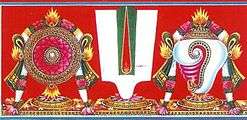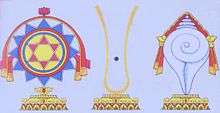Urdhva Pundra

The Urdhva Pundra is a tilak worn by followers of the Hindu sect Vaishnavism to show that they are devotees of Vishnu. It is generally worn on the forehead, but also on other parts of the body. It was introduced by Saint Madhvacharya. The markings are made either as a daily ritual, or on special occasions, and denote which particular lineage, or sampradaya the devotee belongs to. The different Vaishnava sampradayas each have their own distinctive style of tilak based on the siddhanta of their particular lineage. The general tilak pattern is of two or more vertical lines resembling the letter U, which commonly represents the foot of Vishnu.[1]
In Hindu texts
Urdhava Pundra has been part of the Vaishnava tradition, just like Tripundra has been part of the Shaiva tradition.[2] The Vasudeva Upanishad, a Vaishnava tradition text, explains the significance of three vertical lines in Urdhva Pundra Tilaka to be a reminder of Brahma, Vishnu, Shiva; the Vedic scriptures - Rigveda, Yajurveda and Samaveda; three worlds Bhu, Bhuva, Svar; the three syllables of Om - A, U, M; three states of consciousness - awake, dream sleep, deep sleep; three realities - Maya, Brahman and Atman; the three bodies - Sthula, Sukshma, and Karana.[3][4]
Different forms
Vallabha sampradaya
In the Vallabha, Rudra sampradaya the tilak worn is a double vertical red line which is rounded from base. This "U" represents Purna Purushottama Shri Krishna's lotus feet who is the only form of god worshipped in the Vallabha sampradaya.
Madhva sampradaya
The Madhva sampradaya mark two vertical lines with Gopichandana representing Krishna's 'lotus feet'.[5] In between a vertical black line is made from the daily coal of the dhupa (incense). In this sampradaya,worship is done to Narayana or Krishna daily. The coal left after offering incense is used to mark the black line. This is called as angara. Those who are wearing this line have finished the Devara Puja (worship). Underneath the black line, red dot is added to indicate that one has finished eating their lunch.This dot is called as akshate. It is the ash of the banana tree flower petal mixed with turmeric paste. The shape of angara-akshate is like that of a gada (mace). It is supposed to be Pranadeva Sannidhi (have the presence of Vayu Devaru). Those who did not perform daily worship to Narayana wear the simple two line tilak only.
Sri Vaishnavism
The mark here is called Sricharanam. Members of the Sri Vaishnava tradition form tilak with two lines representing the feet of Narayana,[5] with a red line in the middle which representing Lakshmidevi. A small line on the top bridge of the nose which represents that the wearer belongs to the Thenkalai subsect. Because the Sri Vaishnava sampradaya begins with Lakshmi, and because they approach Narayana through Lakshmi, their tilak reflects this process of surrender, known as Saranagati (or sometimes also Prapatti). Within Sri Vaishnavism, this process of surrender (sarangati) to Vishnu. A variant to this is found within the Ramanandi sect, begun by Ramananda, who wear a similar tilak design but in reference to Sita and Rama (whom their devotion is focused upon) rather than Lakshmi and Narayana.

Thenkalai
In South India's Iyengar Tradition there are 2 forms of Tilak. One is Thenkalai (Southern Sect) and other is Vadakalai. (Northern Sect).
Thenkalai are a subsect of the Vaishnavite Iyengar community of Hindu Brahmins. Thenkalais are followers of Ramanuja, Pillai Lokacharya and Manavala Mamuni.
Vadakalai
Vadakalai, meaning Northern school or Northern culture, are a subsect of the Vaishnavite Iyengar community of Hindu Brahmins. In Sanskrit the Vadakalai are referred to as Uttara Kalārya.[6] Vadakalais are followers of Ramanuja and Vedanta Desika.[7][8][9]
Gaudiya Vaishnavism
In the Gaudiya Vaishnava sampradaya the tilak is usually made out of mud from Vrindavan. The main tilak is basically identical to the Madhva tilak. Below the two lines, on the bridge of the nose is the shape of a tulsi leaf, while other vaishnav groups may instead feature the shape of the neem or asoka leaf. The slight difference arose due to the emphasis on direct devotional service such as hearing from the shastras and glorifying the Lord in accordance with Srimad-Bhagavatam. As such, the black line made from the ash of the fire sacrifice is not included. As per Sri Hari Bhakti Vilasa (4.211), the tilaka is a U that begins from the beginning of the nose which is technically 1/3rd the distance from the base to the tip. In due course of time, this original tilaka was modified to suit various divisions and sects.
Nimbarka sampradaya

In Nimbarka Sampradaya, the tilak is made of Gopi-Chandana (the clay from Gopi Kunda lake in Dwarka, Gujarat), as described in the Vasudeva Upanishad. It starts at the bridge of the nose and continues as two vertical lines to the top of the forehead. This is said to represent the temple of God. Within these lines, between the eyebrows is a black dot, made from the slate found in Barsana, Uttar Pradesh, the sacred birthplace of Radha. This is said to represent God as Radha and Krishna together. This tilak personifies the tenets of the Sampradaya, that God is Radha and Krishna together, none else. It is supposed to have been first given to Nimbarka at the time of his initiation by the sage, Narada. The tilak is first given to an initiate by their guru at the time of initiation, and after this, daily the devotee will remember his guru before he adorns the tilaka on his head.
Swaminarayan Sampradaya

The tilak is made of sandalwood paste. This has a cool, soothing effect and the fragrance helps to maintain a pure and clear mind. The chandlo is made of red kum kum (potash nitrate). The tilak represents the Lord and the chandlo represents the muktas that reside within Him. Once the Muktas enter the murti, they will eternally remain there. There is a union between them, i.e. they appear as one, but there is a distinction, the master and the devotee. When the two merge, they appear as one, but in reality they remain distinct in their nature and their attributes, with God remaining the master and the soul forever remaining the servant.
See also
| Wikimedia Commons has media related to Urdhva Pundra. |
References
- ↑ britannica.com - Vaishnavism
- ↑ James Lochtefeld (2002), "Urdhvapundra", The Illustrated Encyclopedia of Hinduism, Vol. 2: N–Z, Rosen Publishing, ISBN 978-0823931798, page 724
- ↑ Sunder Hattangadi (2000), Vasudeva Upanishad, Sama Veda, SanskritDocuments Archives
- ↑ D Dennis Hudson (2008), The Body of God, Oxford University Press, ISBN 978-0195369229, pages 90-95
- 1 2 Vedic Encyclopedia - see Tilak section
- ↑ Pg 205 Students' Britannica India. Books.google.co.in. Retrieved 20 November 2011.
- ↑ T. V. Kuppuswamy (Prof.), Shripad Dattatraya Kulkarni (1966). History of Tamilakam. Darkness at horizon. Shri Bhagavan Vedavyasa Itihasa Samshodhana Mandira. p. 166.
- ↑ Pg.129 Sociology of religion, Volume 1 – by Joachim Wach, University of Chicago press, 1944. Google Books. 3 November 1958. Retrieved 20 November 2011.
- ↑ Pg.107 Kabir, the apostle of Hindu-Muslim unity: interaction of Hindu-Muslim ideas in the formation of the bhakti movement with special reference to Kabīr, the bhakta – Muhammad Hedayetullah, Motilal Banarsidass publication, 1977. Books.google.co.in. Retrieved 20 November 2011.